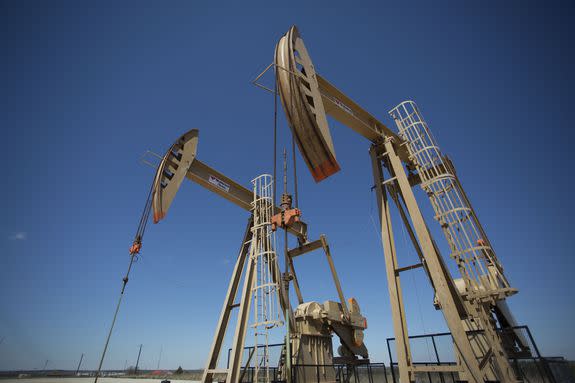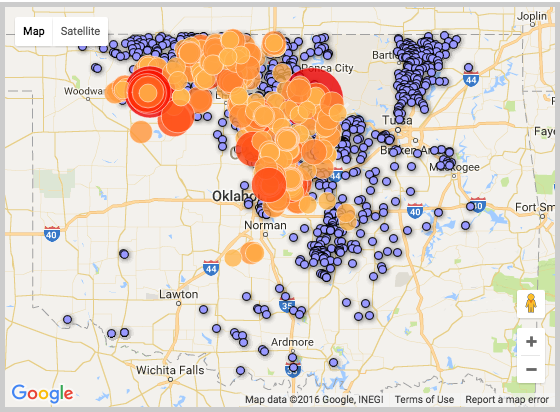Oklahoma's magnitude 5.6 quake comes amid concerns around oil and gas boom

A record-tying earthquake rattled Oklahoma and five surrounding states on Saturday morning.
The 5.6.-magnitude temblor near Pawnee, Oklahoma, is one of thousands to strike the state in the last few years.
State and federal scientists say the swarm of earthquakes in central and north-central Oklahoma is connected to the area's oil and gas companies, which are pumping copious amounts of drilling wastewater into underground disposal wells.
SEE ALSO: Here's why Italy is prone to devastating earthquakes
Oklahoma's Gov. Mary Fallin this weekend declared a state of emergency for Pawnee County after the earthquake struck on Sept. 3 near Pawnee, a city of about 2,200 people.
This is 6th and Harrison in #Pawnee #earthquake #okwx pic.twitter.com/PTDx6W3FNS
— Amy Slanchik (@amyslanchik) September 3, 2016
This is White's Foodliner in #Pawnee #Earthquake #okquake pic.twitter.com/nws23m8a1H
— Amy Slanchik (@amyslanchik) September 3, 2016
Gov. Fallin said nobody was seriously hurt by the earthquake and damage was relatively limited.
In rural Pawnee County, one homeowner suffered minor injuries and three homes were damaged, she said on Twitter. At least six tribal government buildings on the Pawnee Nation's reservation were deemed "uninhabitable," the governor said.
The Saturday earthquake was the strongest to rock Oklahoma since November 2011, when a 5.6-magnitude earthquake struck near Prague, a small town roughly 70 miles south of Pawnee.

Image: U.S. Geological survey
The temblor in Prague (pronounced "PRAY-geh") was then the strongest in Oklahoma's history. That event and a series of related shocks destroyed more than a dozen homes, injured two people and racked up nearly $1 million in damages across Prague.
The U.S. Geological Survey (USGS) determined the 2011 quake was most likely triggered by the injection of wastewater from oil and gas operations, including both conventional oil drilling activities and advanced techniques like fracking.
Energy companies had injected the wastewater in the ground near a fault zone, setting off a seismic reaction, according to the USGS. The agency declared the event the "largest human-caused earthquake associated with wastewater injection."

Image: J Pat Carter/Getty Images
Since then, Oklahoma has experienced an exponential number of earthquakes of magnitude 3.0 or greater — meaning ones strong enough for people to feel.
In the decades before Oklahoma's drilling boom in 2008, the state saw roughly one to three quakes of that size per year, according to the Oklahoma Geological Survey.
In 2011, the annual count jumped to 64. By 2013, the state recorded 109 such earthquakes.
Last year, Oklahoma experienced more than 900 earthquakes of magnitude 3.0 or greater, the Oklahoma Geological Survey reported. The state has seen hundreds more in 2016.

Image: oklahoma geologicla survey
The USGS said it was too early to know whether the Pawnee earthquake was caused by industrial human activities.
"However, we do know that many earthquakes in Oklahoma have been triggered by wastewater injection fluid," the agency said Saturday in a statement. "The USGS will continue to process seismic data in the following days and weeks that will help answer this question."
In response to the Sept. 3 earthquake, the Oklahoma Corporation Commission, which regulates the state's oil and gas sector, ordered at least 37 injection wells to shut down in the 725-square-mile zone around Pawnee.
The schedule for the shutdown: Everything within 5 miles of a 10-mile section of the fault in question is to shut down within 7 days.
— Governor Mary Fallin (@GovMaryFallin) September 3, 2016
Oklahoma isn't the only state to experience "induced seismicity" — aka human-caused earthquakes — as a result of oil and gas wastewater injections.
The USGS estimated in March that around 7 million people live and work in areas of the central and eastern United States with potential for damaging shaking from induced earthquakes

Image: U.S. Geological survey
Six states bear the brunt of those potential hazards, the federal agency said. In order from highest to lowest potential hazard, they are: Oklahoma, Kansas, Texas, Colorado, New Mexico and Arkansas.
The USGS report was the first time the agency identified the potential ground-shaking hazards from both human-induced and natural earthquakes — a move that reflects the rising significance of induced earthquakes from wastewater injections.
USGS scientists found 21 areas with increased rates of induced seismicity, including within small areas of Alabama and Ohio.
